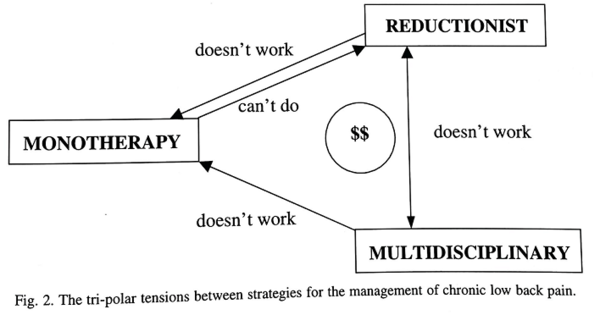Low Back Pain Treatment Strategies
Historical Context
Pre 1980s
- Empirical conservative treatment (drugs, traction, ultrasound, exercises, physical therapy)
- Try monotherapies one after the other, hoping next one will work
- If no improvement, referred for surgery (empirical surgery)
Post 1980s
- Around 1980s standard approach challenged
- Behavioural approach emerged: treatments weren’t working because of unaddressed psychological/behavioural issues
- High-tech treatments (spinal cord stimulation, intraspinal drug delivery) emerged when behavioural approach also found to not work
- Reductionism: precision diagnosis needed; pin-point the lesion
- Tensions between approaches; each thinks other doesn’t work. Need for following the evidence
Tripolar Tension
Monotherapy Pole: Single types of treatment being delivered by a single individual. The patient is instructed to try one therapy, and then move on to the next if that did not work. If none of the conservative treatments worked then they would move on to surgery, or other high-tech interventions.
Multidisciplinary Behavioural Therapy Pole: This strategy delivers multiple strategies by a team of individuals. They posit that a correct diagnosis cannot be made, and cannot be treated medically or surgically. Therefore making pain as the target of therapy is not helpful. However, the patient can be helped by addressing their psychological distress, physical behaviour, catastrophising, fear-avoidance behaviour, etc. They can be taught skills such as pacing, and coping mechanisms to try and improve their function.
Reductionism Pole: The reductionists aim to pinpoint the source of pain and stop the pain. They assume that the patient does have a lesion that has not yet been diagnosed. Treatments were thus being applied empirically, even surgery, without paying attention to a specific diagnosis. Therefore they were not working. The reductionists also posit that even symptomatic or behavioural therapy may not be appropriate when there may still be a cause of pain to be discovered. Reductionism requires specialised skills and facilities that may not be available in all centres.


